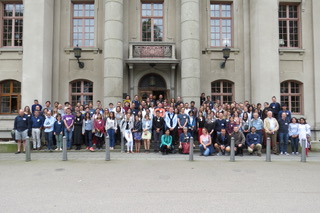På svenska nedan
During four days in June (9-12 / 6), an EMBO Workshop was held at Örenäs Slott entitled “Bacterial Cell Division: Closing the Gap”. 123 participants from 23 countries gathered to discuss the latest advances in our understanding of bacterial cell division and proliferation. The workshop followed a series of similar meetings sponsored by EMBO with some regularity since 1980. Organizers for this meeting were Tanneke den Blaauwen (Swammerdam Institute for Life Science, University of Amsterdam), Daniel Daley (Department of Biochemistry and Biophysics, Stockholm University ), and Klas Flärdh (Department of Biology, Lund University), and it was organized with the support of EMBO and the Swedish Research Council. Among the 22 invited speakers were both many of the foremost established experts in the area and several promising younger researchers at the beginning of their careers. From the other participants, 85 abstracts had been submitted, of which 19 were selected for short lectures while the others were presented as posters.
The presentations were consistently of very high quality and covered a wide range of approaches. New methods in microbial genetics were mixed with advanced and high-resolution microscopy, protein structure, biochemistry, biophysics, bioinformatics and modeling. The diversity of the organisms studied was also striking. Classic model systems such as Escherichia coli, Bacillus subtilis and Caulobacter crescentus, were mixed with pathogens like Vibrio cholerae, Mycobacterium tuberculosis, and Streptococcus pneumoniae, and more unusual organisms such as stalked Hyphomonas, mycelium-forming streptomycetes, planctomycetes, and even a nematode sybiont that divides along its longitudinal axis. From this diversity, new trends and insights emerged about the structure and function of the cell division machinery, the properties of cytoskeletal proteins, bacterial cell wall and its formation, and how cell division is coordinated with replication and segregation of chromosomes. Also the effects of antibiotics were discussed, as well as development of new types of antibiotics. The discussions were lively and constructive, and the good food and the fantastic environment at Örenäs also contributed strongly to a very successful conference. One free afternoon was dedicated to selectable excursions with visits to Ven, a guided nature walk in the surroundings, or study visits to MAX IV.
Bakteriell celldelning – en workshop på Örenäs
Under fyra dagar i juni (9-12/6) hölls en EMBO Workshop på Örenäs slott med titeln “Bacterial Cell Division: Closing the Gap”. 123 deltagare från 23 länder var samlade för att diskutera de senaste framstegen i vår förståelse av bakteriers celldelning och förökning. Workshopen följde i en serie av liknande möten som organiserats i EMBOs regi med viss regelbundenhet sedan 1980. Organisatörer för detta möte var Tanneke den Blaauwen (Swammerdam Institute for Life Science, University of Amsterdam), Daniel Daley (Institutionen för biokemi och biofysik, Stockholms universitet), och Klas Flärdh (Biologiska institutionen, Lunds universitet), och det ordnades med stöd av EMBO och Vetenskapsrådet. Bland de 22 inbjudna talarna fanns både många av de främsta etablerade experterna i området och flera lovande yngre forskare i början sina karriärer. Från övriga deltagare hade 85 abstracts skickats in, varav 19 valdes ut för korta föredrag medan övriga presenterades som posters.
Presentationerna var genomgående av mycket hög kvalitet och täckte ett brett spektrum av angreppssätt. Nya metoder inom mikrobiell genetik blandades med avancerad och högupplöst mikroskopi, proteinstruktur, biokemi, biofysik, bioinformatik och modellering. Även diversiteten bland de organismer som studerades var slående. Klassiska modellsystem som Escherichia coli, Bacillus subtilis och Caulobacter crescentus, blandades med sjukdomsalstrare som Vibrio cholerae, Mycobacterium tuberculosis, och Streptococcus pneumoniae, och mer ovanliga organismer såsom stjälkförsedda Hyphomonas, myceliebildande streptomyceter, planktomyceter, och till och med en nematodsymbiont som delar sig längs cellens längdaxel. Ur denna mångfald trädde nya trender och insikter fram om celldelningsmaskineriets struktur och funktion, om cytoskelettproteiners egenskaper, om bakteriecellväggen och hur den bildas, om hur celldelning koordineras med replikation och segregation av kromosomer, Även effekter av antibiotika diskuterades, samt om utveckling av nya typer av antibiotika. Diskussionerna var livliga och konstruktiva, och den goda maten och fantastiska miljön ute på Örenäs bidrog också starkt till en mycket lyckad konferens. En eftermiddag ägnades åt valbara utflykter med besök på Ven, naturguidning i omgivningarna, eller studiebesök på MAX IV.
Text by/av Klas Flärd

